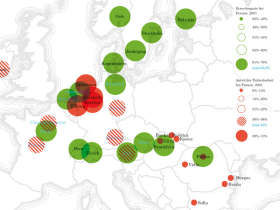Linz Atlas

Linz Atlas
Copyright: FLAG Aubry/Broquard & Jonas Voegeli
ON THE QUALITY OF LIFE HERE AND ELSEWHERE
Date of publication: End of 08
Idea / Concept / Realization: Peter Arlt
Linz is situated at the province’s wasp waist. This is where the centre is. It is only here, of all places in Upper Austria, that a capital could have developed. The key question that LINZ ATLAS sets out to answer is: What makes life in this city worth living for its inhabitants? And how and on what scale is this to be measured? For LINZ ATLAS a selection has been made from the wealth of available data that is immediately relevant to the everyday reality of individual residents. For some, a roof above their head is all important, for others the great variety of cultural events to choose from, a well structured system of child care, the quality of the schools, of public transport or even the air. But although the expectations of different segments of the population differ in the way they are weighted, one aspect remains the same: Social and ecological criteria in the assessment of the quality of life are gaining in importance all the time. How are the city’s resources put to use? Applying strict standards makes a European comparison possible. Linz is the point of reference for this book that assigns Linz its place within a United Europe.
Linz on the Blue Danube and under the Red Sky
‘As someone born in the years after the war I have always thought of myself – with a certain sense of pride – as a child of the steel city. I earned my first money in the holidays temping at the ‘Verstaatlichte’ [translator’s note: this was the then nationalized VOEST] and admired the red sky, which was the result of the ‘Abstich’, the emptying of the furnace. And I was there when SK VOEST became Austria’s soccer champions in 1973. It wasn’t until much later, when the proverbially poor Linz air was beginning to get a really bad name and the mayor of Linz merely quipped, ‘There’s also dust in the air in the Sahara’ that my city of steel pride began to show its first cracks. Fortunately the industry, nationalized no longer, managed to weather the steel crisis of the nineteen eighties, the air has got much better, and Linz and environs with more than 600,000 inhabitants can boast excellent economic statistics. All this does not necessarily say much about what it is like living in Linz. My personal favourite in Linz is the Danube, which may not be blue but its waters are clean and allow you to lie on pebble beaches in the heart of the city and go for a swim. And as a further boon you still get the red sky above Linz at night.’ (Peter Arlt)
GRAPHICS AND LAYOUT //
Jonas Voegeli and FLAG
A Linz09 project





